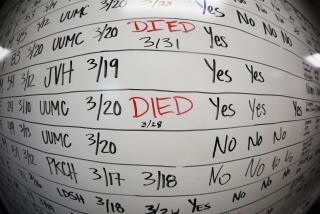Estimates of Number of People Infected With HIV Are Core of Debate
- Share via
In some circles, they call it The Number--with the emphasis on the upper case. Because the number of Americans infected with the human immunodeficiency virus has become a moving target of considerable public and political interest.
The number is an indicator of how many people will develop AIDS. As such, it influences levels of funding for research, education and services. Some people contend that current levels are far too low; others suggest that the epidemic is being exaggerated.
Last week, the federal estimate of 945,000 to 1.4 million HIV-infected Americans came under question once again. Joel W. Hay, a health economist at the conservative Hoover Institution, called the federal figure too high by far. His estimate: 500,000 to 800,000 infected.
Hay’s figures came five weeks after analysts from another think tank, the Hudson Institute in Indianapolis, announced that they believed the government figures are too low by half. Their figure: Between 1.9 million and 3 million.
One month before that, the New York City Health Department halved its estimate of the number of infected city residents from 400,000 to 200,000. The decision prompted protesters to occupy the health commissioner’s office and picket his apartment house.
At issue here are the assumptions used in the mathematical models used to estimate the numbers of people infected--models that can extrapolate from the number of people being diagnosed with AIDS each year to determine how many more might be infected.
Those models require many assumptions about such things as how many gay men there are in the population and how fast the virus is spreading. The models are limited by uncertainty about modes of transmission, human behavior and the natural history of the virus.
“You have to make assumptions on all this,” said Dr. Timothy J. Dondero, chief of the seroepidemiology branch of the Centers for Disease Control. “That’s where the differences in opinion come out--what’s the most reasonable assumption? Because nobody knows the truth.”
More to Read
Sign up for Essential California
The most important California stories and recommendations in your inbox every morning.
You may occasionally receive promotional content from the Los Angeles Times.












